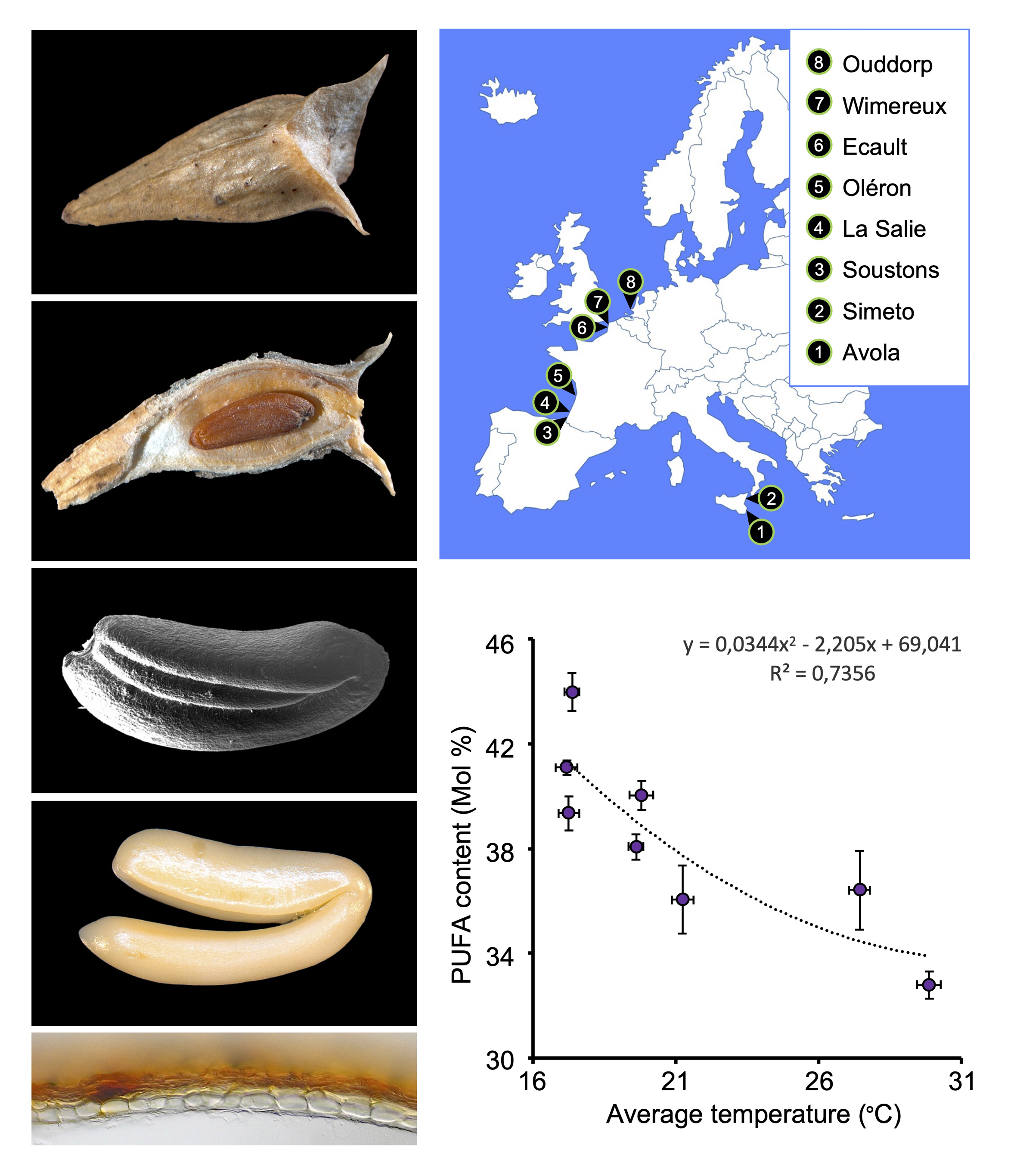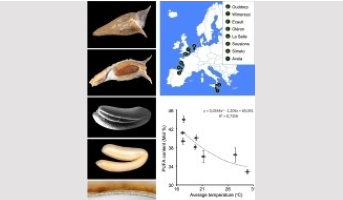Understanding the specifics of fatty acid metabolism in the endosperm of Brassicaceae
Brassicaceae
seed
endosperm
fatty acid
oil
chemical biodiversity
Publications from the SEED-DREAM team in The Plant Journal and in Experimental Botany
The seeds of Brassicaceae, whether wild or cultivated species, accumulate oil in the embryo and endosperm. Since the embryo occupies most of the space in the mature seed (and accumulates 90% of the reserves), its metabolism has been relatively well characterized. It has long been assumed that the metabolism of the endosperm was similar to that of the embryo. The emergence of analytical techniques that allow the two zygotic tissues to be studied separately shows that this is not the case.
Cakile maritima, a wild halophyte* Brassicaceae that thrives along coastlines, offers a striking example. In the seeds of this species, half of the fatty acids in the endosperm are omega-7 monounsaturated fatty acids, whereas these are barely detectable in the embryo. The embryo, on the other hand, shows a stronger induction of omega-9 and polyunsaturated fatty acid (omega-6 and omega-3) biosynthesis pathways, reflecting specific regulation of fatty acid metabolism in each tissue. In addition, seeds collected from different ecological niches along a latitudinal gradient reveal that environmental temperature affects the polyunsaturated fatty acid content of the embryo, but much less so that of the endosperm.
To understand the physiological function of this differentiated regulation of fatty acid metabolism in the zygotic tissues of Brassicaceae seeds, new molecular tools that allow tissue-specific manipulation of fatty acid metabolism are essential. Screening of available transcriptomic data in Arabidopsis revealed that the At3g29190 (AtTPS15) gene is specifically expressed in the endosperm during seed filling. Its promoter sequence has been successfully used in various ways to modify the fatty acid composition of Arabidopsis endosperm without altering that of the embryo.
These tools can now be used to address a question that currently remains unanswered: do the specific fatty acid composition characteristics of Brassicaceae seed endosperm confer them a selective advantage?
Among these Brassicaceae, the characteristics of C. maritima, which has a high oil content in its seeds and is able to thrive in saline environments with minimal inputs, make it an interesting species for the diversification of oilseed crops.

* halophyte refers to a plant adapted to salty environments.
Research developed at the Institute Jean-Pierre Bourgin for Plant Sciences in collaboration.
Cakile maritima, a wild halophyte* Brassicaceae that thrives along coastlines, offers a striking example. In the seeds of this species, half of the fatty acids in the endosperm are omega-7 monounsaturated fatty acids, whereas these are barely detectable in the embryo. The embryo, on the other hand, shows a stronger induction of omega-9 and polyunsaturated fatty acid (omega-6 and omega-3) biosynthesis pathways, reflecting specific regulation of fatty acid metabolism in each tissue. In addition, seeds collected from different ecological niches along a latitudinal gradient reveal that environmental temperature affects the polyunsaturated fatty acid content of the embryo, but much less so that of the endosperm.
To understand the physiological function of this differentiated regulation of fatty acid metabolism in the zygotic tissues of Brassicaceae seeds, new molecular tools that allow tissue-specific manipulation of fatty acid metabolism are essential. Screening of available transcriptomic data in Arabidopsis revealed that the At3g29190 (AtTPS15) gene is specifically expressed in the endosperm during seed filling. Its promoter sequence has been successfully used in various ways to modify the fatty acid composition of Arabidopsis endosperm without altering that of the embryo.
These tools can now be used to address a question that currently remains unanswered: do the specific fatty acid composition characteristics of Brassicaceae seed endosperm confer them a selective advantage?
Among these Brassicaceae, the characteristics of C. maritima, which has a high oil content in its seeds and is able to thrive in saline environments with minimal inputs, make it an interesting species for the diversification of oilseed crops.

* halophyte refers to a plant adapted to salty environments.
Research developed at the Institute Jean-Pierre Bourgin for Plant Sciences in collaboration.
Back

zoom
Legend: Characterization of fatty acid metabolism in the zygotic tissues of Cakile maritima seeds. Left column: C. maritima fruit (intact or dissected), seed, embryo, and endosperm. Right column: C. maritima seed collection sites and variation in polyunsaturated fatty acid content in the embryo depending on the ambient temperature at the collection sites.
IJPB highlights
Contact: Sébastien Baud, contact
References
> Miray R, Kazaz S, To A, Baud S. Identification of a promoter region specifically active in the maturing endosperm of Arabidopsis seeds and its use for targeted modification of fatty acid metabolism. Plant J. 2025. doi: 10.1111/tpj.70038
> Miray R, Frazzetto P, To A, Ratahiry S, De Vos D, Toorop PE, Puglia GD, Baud S. Comparative analysis of storage compound metabolism in the embryo and endosperm of Cakile maritima seeds. J Exp Bot. 2025. doi: 10.1093/jxb/eraf314
IJPB team
"Seed - Development, Regulation, and Metabolism" SEED-DREAM team
Collaborating teams
> Institute for Agriculture and Forestry Systems in the Mediterranean (ISAFoM), National Research Council of Italy, Catania, Italy.
> Department of Biological, Geological and Environmental Sciences, University of Catania, Catania, Italy.
> Royal Botanic Gardens, Kew, United Kingdom.
Legend: Characterization of fatty acid metabolism in the zygotic tissues of Cakile maritima seeds. Left column: C. maritima fruit (intact or dissected), seed, embryo, and endosperm. Right column: C. maritima seed collection sites and variation in polyunsaturated fatty acid content in the embryo depending on the ambient temperature at the collection sites.
IJPB highlights
Contact: Sébastien Baud, contact
References
> Miray R, Kazaz S, To A, Baud S. Identification of a promoter region specifically active in the maturing endosperm of Arabidopsis seeds and its use for targeted modification of fatty acid metabolism. Plant J. 2025. doi: 10.1111/tpj.70038
> Miray R, Frazzetto P, To A, Ratahiry S, De Vos D, Toorop PE, Puglia GD, Baud S. Comparative analysis of storage compound metabolism in the embryo and endosperm of Cakile maritima seeds. J Exp Bot. 2025. doi: 10.1093/jxb/eraf314
IJPB team
"Seed - Development, Regulation, and Metabolism" SEED-DREAM team
Collaborating teams
> Institute for Agriculture and Forestry Systems in the Mediterranean (ISAFoM), National Research Council of Italy, Catania, Italy.
> Department of Biological, Geological and Environmental Sciences, University of Catania, Catania, Italy.
> Royal Botanic Gardens, Kew, United Kingdom.